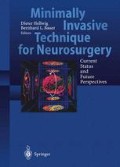Summary
We have tested a prototype infrared guided computerized navigation system (SPOCS; Aesculap/ISG) for the microsurgical treatment of intra-cranial pathology. Forty-eight patients with a total of 53 lesions — 14 (26.4%) < 2 cm, 33 (62.3%) 2–4 cm, 6 (11.3%) > 4 cm — were included. The navigator was applied for biopsy procedures in three cases, for cyst fenestration/shunting in two cases and for general microsurgery-assisting purposes in the remaining 48 lesions, including transnasal approaches. The accuracy of the intra-operative navigation was in the range of 3 mm or better in 39 patients (81.3%) during the course of the operation and it had to be aborted in seven patients (14.6%) due to technical dropouts and due to other problems in two patients (4.2%). The level of accuracy achieved was not altered by the patient’s position except for an unsatisfactory result with the sitting position due to skin movement together with the fiducial markers. The system proved to be helpful for craniotomy planning and for intraoperative guidance in situations of a narrow visual field. It was especially useful for the localization of small lesions in highly eloquent brain regions and for the definition of the margin of large lesions.
Access this chapter
Tax calculation will be finalised at checkout
Purchases are for personal use only
Preview
Unable to display preview. Download preview PDF.
References
Apuzzo MLJ (1996) The Richard C. Schneider lecture. New dimensions of neurosurgery in the realm of high technology: possibilities, practicalities, realities. Neurosurgery 38: 625–639
Barnett GH, Kormos DW, Steiner CP, Weisenberger J (1993) Intraoperative localization using an armless, frameless stereotactic wand. J Neurosurg 78:510–514
Barnett GH, Kormos DW, Steiner CP, Weisenberger J (1993) Use of a frameless, armless stereotactic wand for brain tumor localization with two-dimensional and three-dimensional neuroimaging. Neurosurgery 33: 674–678
Barnett GH, Steiner CP, Weisenbeger J (1995) Intracranial meningioma resection using frameless stereotaxy. J Image Guided Surg 1:46–52
Cedzich C, Taniguchi M, Schäfer S, Schramm J (1996) Somatosensory evoked potential phase reversal and direct motor cortex stimulation during surgery in and around the central region. Neurosurgery 38: 962–970
Germano IM (1995) The neurostation system for image-guided frameless stereotaxy. Neurosurgery 37: 348–350
Golfinos JG, Fitzpatrick BC, Smith LR, Spetzler RF (1995) Clinical use of a frameless stereotactic arm: results of 325 cases. J Neurosurg 83:197–205
Imai F, Ogura Y, Kiya N, Zhou J, Ninomiya T, Katada K, Sano H, Kanno T (1996) Synthesized surface antomy scanning (SSAS) for surgical planning of brain metastasis at the sensorimotor region: initial experience with 5 patients. Acta Neurochir (Wien) 138: 290–293
Kato A, Yoshimine T, Hayakawa T, Tomita Y, Ikeda T, Mitomo M, Harada K, Mogami H (1991) A frameless, armless navigational system for computer-assisted neurosurgery. J Neurosurg 74: 845–849
Reinhardt HF,Horstmann GA,Gratzl O (1993) Sonic stereometry in microsurgical procedures for deep-seated brain tumors and vascular malformations. Neurosurgery 32:51–57
Reinhardt HF, Trippel M, Westermann B, Horstmann GA, Gratzl O (1996) Computer assisted brain surgery for small lesions in the central sensorimotor region. Acta Neurochir(Wien) 138:200–205
Rezai A, Hund M, Kronberg E, Zonenshayn M, Cappell J, Ribary U, Kall B, Llinâs R, Kelly P (1996) The interactive use of magnetoencephalography in stereotactic image-guided neurosurgery. Neurosurgery 39: 92–102
Ryan M, Erisckson R, Levin D, Pellizari C, MacDonald R, Dohrmann G (1996) Frameless stereotaxy with real-time tracking of patient head movement and retrospective patient-image registration. J Neurosurg 85: 287–292
Sandeman DR, Patel N, Chandler C, Nelson RJ, Coakham HB, Griffith HB (1994) Advances in image-directed neurosurgery: preliminary experience with the ISG viewing wand compared with the Leksell G frame. Br J Neuosurg 8:529–544
Sipos E, Tebo S, Zinreich S, Long D, Brem H (1996) In vivo accuracy testing and clinical experience with the ISG viewing wand. Neurosurgery 39:194–204
Smith KR, Frank KJ, Bucholz RD (1994) The neurostation - a highly accurate, minimally invasive solution to frameless stereotactic neurosurgery. Comp Med Imaging Graph 18:247–256
van Roost D, Meyer B, Schaller C, Schramm J (1996) Image-guided epilepsy surgery: first experience with a freehand neuronavigation system in selective amygdalohippocam-pectomy. Annual meeting of the American Association of Neurological Surgeons. Minneapolis, MM, USA, April1996
Watanabe E, Mayanagi Y, Kosug Y, Manaka S, Takakura K (1991) Open surgery assisted by the neuronavigator, a stereotactic, articulated, sensitive arm. Neurosurgery 28:792–800
Zamorano L, Kadi AM, Dong A (1992) Computer-assisted neurosurgery: simulation and automation. Stereotact Funct Neurosurg 59:115–122
Editor information
Editors and Affiliations
Rights and permissions
Copyright information
© 1998 Springer-Verlag Berlin Heidelberg
About this paper
Cite this paper
Schaller, C., Meyer, B., van Roost, D., Schramm, J. (1998). Neuronavigation-Assisted Microsurgery of Intracranial Lesions. In: Hellwig, D., Bauer, B.L. (eds) Minimally Invasive Techniques for Neurosurgery. Springer, Berlin, Heidelberg. https://doi.org/10.1007/978-3-642-58731-3_30
Download citation
DOI: https://doi.org/10.1007/978-3-642-58731-3_30
Publisher Name: Springer, Berlin, Heidelberg
Print ISBN: 978-3-642-63701-8
Online ISBN: 978-3-642-58731-3
eBook Packages: Springer Book Archive

